Fall Mantel Decorating Ideas
Wildly Beautiful: Nature-Inspired Fall Mantel Decorating Ideas with Acorns & Woodland Charm
Fall mantels feel most inviting when they celebrate the richness of the season rather than holding back. Branches, acorns, moss, and layered greenery bring depth and warmth that a single vase or sparse setup can’t achieve. The key is creating a mantel that feels abundant, natural, and thoughtfully styled—bringing the outdoors inside in a way that feels timeless for autumn.
This guide shows how to mix woodland finds with elevated accents so your mantel feels both creative and cohesive. From gathering branches in your yard to blending real and faux elements for longevity, you’ll see how simple choices shape a mantel that looks full, balanced, and seasonal. Each idea highlights a different way to tell a story with nature, giving you options that go beyond the usual rustic look.
Woodland Abundance Mantel
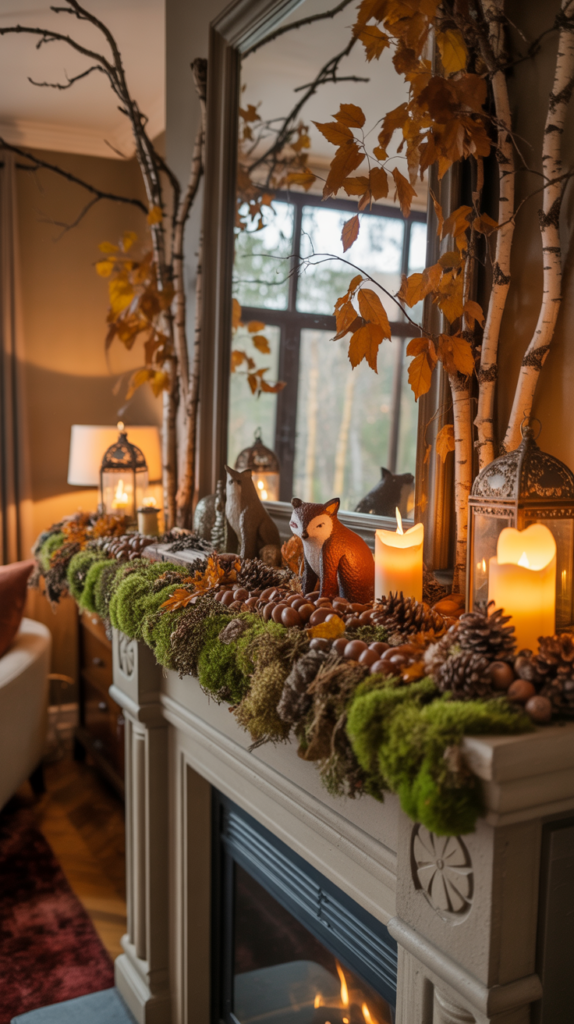
Create a mantel that feels like a walk through the woods by layering natural elements in generous clusters. Start with a base of moss or faux greenery to give the scene a soft, grounded look. Add branches and wood slices to build height and structure.
Scatter acorns, pinecones, and dried leaves across the mantel for texture and variety. If you gather acorns outdoors, bake them at a low temperature to remove insects before styling. Mixing real finds with faux pieces keeps the display both authentic and long-lasting.
Introduce small woodland animal accents, like deer or owls, to bring character to the arrangement. Brass candlesticks or lanterns add a warm glow that balances the organic textures. A mirror or framed art behind the display can reflect light and make the mantel feel fuller.
Aim for abundance rather than minimalism. Let branches cascade slightly, allow moss to spill over edges, and layer items so the mantel reads as one complete scene. Step back once everything is in place and adjust until the arrangement feels cohesive and balanced.
Acorn Garland Elegance
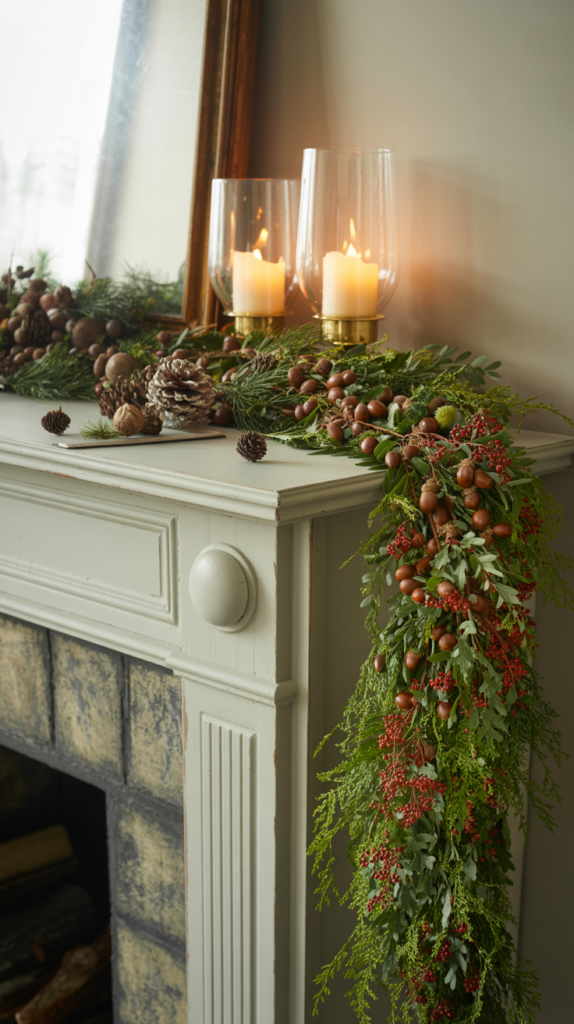
An acorn garland brings a woodland element to your mantel that feels both natural and refined. String acorns onto twine or thin wire, then layer the strands in soft swags across the mantel for a sense of flow. The shape adds movement without overwhelming the rest of your display.
For a polished look, mix the garland with branches or faux greenery to create fullness. The contrast of smooth acorns against textured leaves or moss gives depth and keeps the arrangement from looking flat. A few brass or glass accents nearby add warmth and balance.
Try pairing the garland with oversized hurricane lanterns or tall candlesticks. Their height frames the mantel and turns the acorn strands into a defined focal point. This combination feels intentional, blending rustic materials with more elevated pieces.
Gather acorns outdoors, but bake them briefly to remove insects before using. This simple step keeps your mantel clean and ensures the garland lasts through the season. Editing the final arrangement—stepping back to adjust symmetry or highlight a centerpiece—helps the design read as a complete, styled scene.
Forest Floor Layers
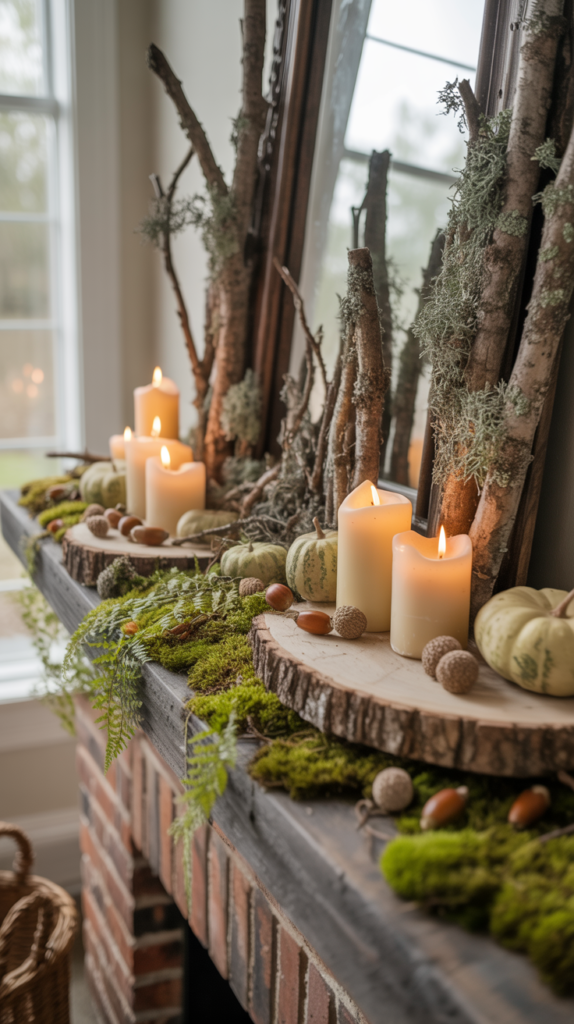
Think of your mantel as a woodland path. Start with a base of moss to mimic the soft ground layer, then add ferns or faux greenery to build texture. This creates a natural foundation that feels grounded and full.
Layer in lichen-covered branches or small wood slabs to add height and variation. Place a few clusters of candles on the slabs so the light feels warm and organic, like a glow between trees.
Slip in seasonal details without overwhelming the scene. Miniature gourds or pinecones work well, especially when grouped in threes for balance. Keep the palette earthy with greens, browns, and muted oranges.
For extra depth, mix real finds with crafted pieces. Brass candlesticks or a vintage lantern give contrast to the raw textures. The mix of natural and polished elements helps the mantel feel styled rather than scattered.
Step back and adjust until the layers read as one complete vignette. The goal is a mantel that feels abundant yet intentional, echoing the richness of the forest floor without becoming cluttered.
Branches in Bloom
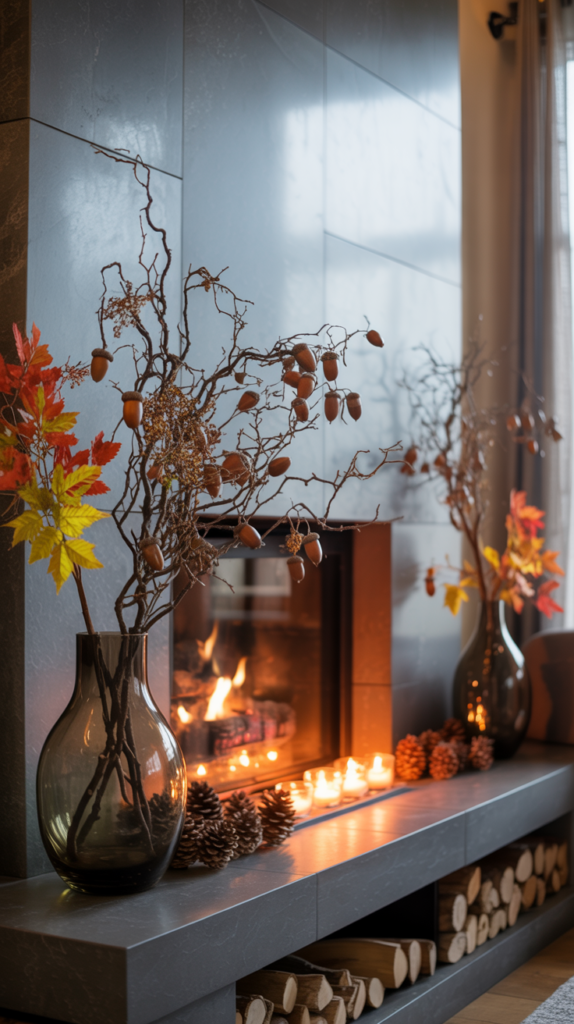
Frame your fireplace with tall branches placed in oversized vases at each end of the mantel. Their height creates a natural arch that feels like woodland art, drawing the eye upward and giving the whole display structure.
Balance the vertical lines with greenery and seed pods spread across the shelf. Layering moss, acorns, and dried stems fills in the space and keeps the arrangement from feeling sparse. Bake collected acorns briefly in the oven to make sure they’re insect-free before styling.
Mix in a few faux sprigs if you want more fullness. This helps the display last through the season while still keeping a natural look.
For a polished finish, pair the branches with brass candlesticks or a simple mirror. These elements ground the scene and keep it from looking like a pile of foraged finds.
Step back once everything is in place and edit the arrangement. Keep a clear focal point, and decide whether symmetry or an off-center balance works best for your room.
Woodland Storybook Mantel
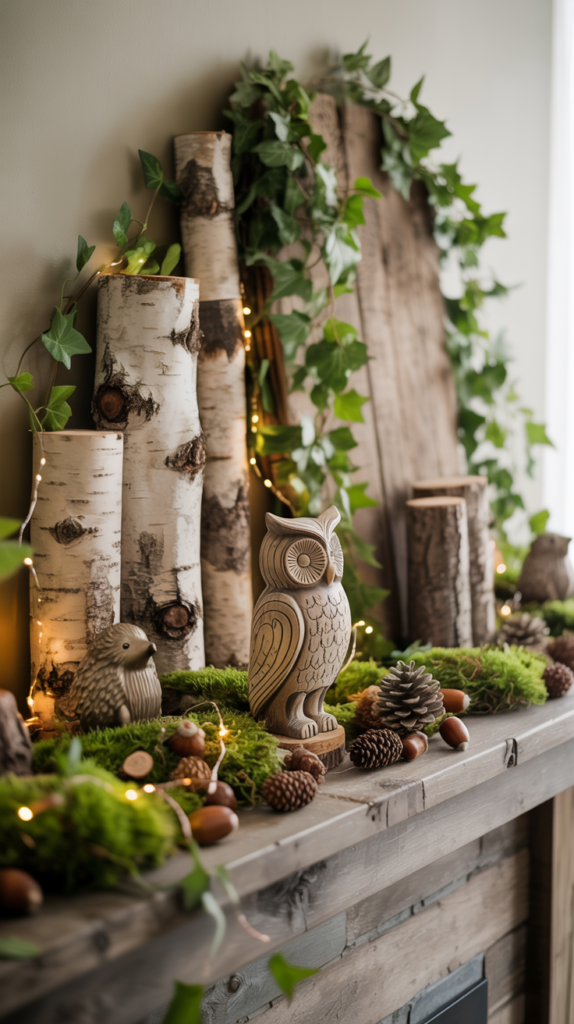
Create a mantel that feels like a woodland scene from a fairytale. Start with a base of birch logs or stacked wood pieces to ground the display. Layer moss across the surface to soften edges and bring in a natural, forest-floor look.
Add clusters of acorns or pinecones for small details that feel authentic. If you gather acorns outside, bake them briefly to remove insects before styling. Mix in faux greenery like ivy or grapevine to add fullness and movement that lasts through the season.
Introduce woodland figurines such as owls, foxes, or hedgehogs in muted tones. These add charm without making the display look like children’s décor. Brass candlesticks or lanterns give contrast and a warm glow that elevates the natural elements.
Step back once everything is in place and edit the scene. Keep a clear focal point, whether it’s a mirror, an oversized branch, or a central lantern. Aim for balance so the mantel feels layered and abundant, not crowded.
Golden Woodland Glow
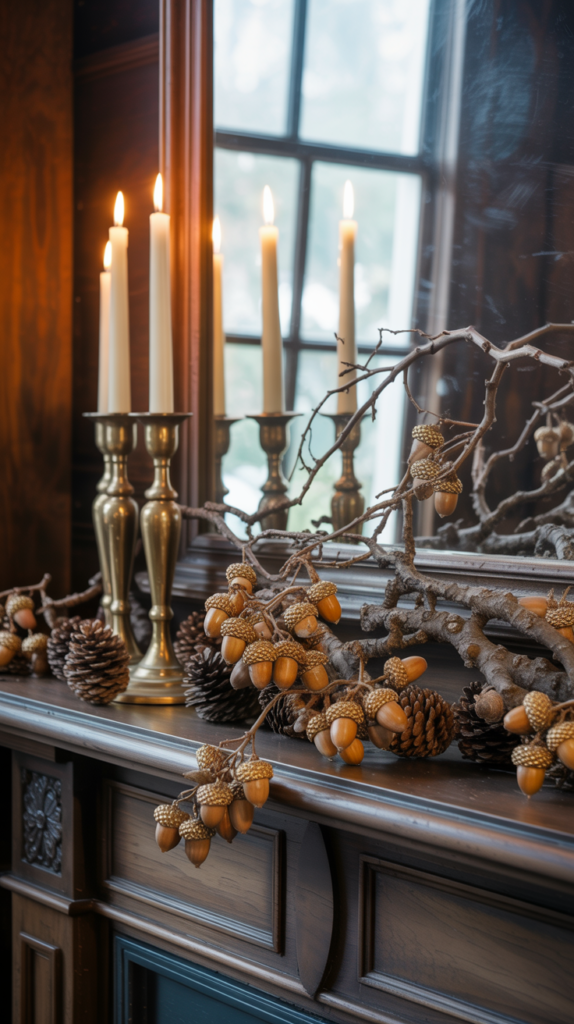
Create a mantel that feels like a golden woodland scene by layering branches, acorns, and warm metallic accents. The mix of natural finds with brass candlesticks or lanterns gives the display a soft glow that feels both rustic and refined.
Gather acorns from outside and bake them at a low temperature to remove insects before styling. Try painting a few in a muted gold finish to scatter among natural ones for subtle shine. This small detail adds depth without overwhelming the arrangement.
Place tall branches in a simple vase or jar to frame the mantel. Their height balances the lower layers of candles and acorns, giving the display structure and focus.
Add brass candlesticks or glass votives in varying heights to reflect light across the mantel. The golden shimmer pairs well with the natural tones of bark, moss, and acorns, creating a cohesive look.
Step back once everything is in place and adjust for balance. Decide whether symmetry or a slightly off-center arrangement feels right for your space. The goal is a warm, woodland-inspired focal point that glows on autumn evenings.
Choosing Natural Elements for a Fall Mantel
A well-styled fall mantel relies on seasonal greenery and textured details that feel both organic and intentional. Using foliage with rich autumn colors and pairing it with layered materials creates a balanced display that feels warm, grounded, and complete.
Selecting Seasonal Foliage
Start with greenery that reflects the season. Eucalyptus, magnolia leaves, and dried hydrangeas bring depth and color shifts that last beyond a single week. Mix in branches with berries or seed pods for a more woodland feel.
Layering matters. Place fuller stems at the base, then weave in lighter sprigs for movement. This creates a natural flow across the mantel instead of a flat line.
For a polished look, combine real clippings with faux stems. Fresh foliage adds authenticity, while artificial greenery keeps the display from thinning out over time. This mix also saves you from having to constantly replace wilted leaves.
If you gather items outdoors, bake acorns or pinecones at low heat to remove insects. This step ensures your arrangement stays clean and safe indoors.
Incorporating Organic Textures
Texture is what makes a fall mantel feel rich and layered. Mix smooth surfaces like polished pumpkins or brass candlesticks with rougher elements such as bark, moss, or woven baskets. The contrast creates depth without overwhelming the eye.
Think in layers rather than single pieces. Place a moss runner or burlap fabric as a base, then stack branches, pinecones, and gourds in varying sizes. This approach builds a scene rather than a row of objects.
Use repetition sparingly. A cluster of three small pumpkins or two matching lanterns feels intentional, while too many duplicates can look cluttered. Editing after styling helps the mantel feel cohesive and balanced.
For added dimension, vary the height of objects. Tall candlesticks, medium garlands, and low decorative accents create a rhythm that guides the eye across the display.
Styling Tips for a Cohesive Look
A well-styled mantel feels intentional, not random. The key is to guide the eye with balanced colors, shapes, and layers so the whole arrangement looks unified while still celebrating seasonal abundance.
Balancing Colors and Shapes
Start by choosing a color palette that feels natural but still has contrast. Warm tones like rust, amber, and deep green pair well with neutral backdrops. Metallic accents in brass or copper add brightness without overwhelming the scene.
Think about shape variety. Mix round forms such as acorns, gourds, or moss balls with taller pieces like candlesticks or foraged branches. This contrast prevents the mantel from looking flat.
Use symmetry to anchor the design. For example:
| Element | Placement Idea |
|---|---|
| Tall candlesticks | One on each side |
| Garland or greenery | Draped across center |
| Small accents (pinecones, votives) | Clustered in odd numbers |
Edit once everything is placed. If one side feels heavier, shift or remove an item until the arrangement feels balanced.
Layering Decor for Depth
Depth makes the mantel look styled instead of staged. Begin with a backdrop, such as a mirror, framed art, or even a wreath. This anchors the display and gives height.
Next, layer greenery or garlands along the base. Faux stems mixed with real branches or dried leaves create fullness. Place medium pieces like lanterns or baskets slightly in front, then add smaller accents—acorns, mini pumpkins, or votives—at the very front edge.
Think in three planes: back, middle, and front. Each should have something of interest, but avoid crowding. Leave a few open spaces so the eye can rest.
Finish by checking the scene from across the room. A layered mantel should read as one cohesive vignette, not a row of separate objects.
